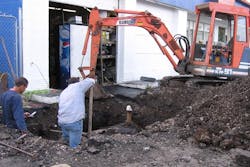History: It’s a subject that probably hasn’t seemed important since junior high and has long since been relegated to the corner of one’s mind labeled “Things to Forget.” Most famous for an ability to repeat itself, one of history’s lesser-known tendencies is to reach through the ground it was buried in years before and throw dirt lest anyone forget it was there.
A rural shop in Dekalb County, Ill., whose owner has been restoring cars and painting recreation vehicles there for 20 years, awaits the results of a second environmental study on the property, which the city is in the process of buying. The facility dates back to the 1800s when it was used as a feed mill, a welding shop and for snowmobile storage, and because of its age, the building may have asbestos, lead paint and harmful chemicals found in older electrical equipment. More contamination is likely from the leaking drums and debris found elsewhere on the property, but its proximity to long-used railroad tracks practically guaranteed that the environmental testing would be needed.
Perhaps a more common example has a Boston shop owner tiptoeing around his contaminated body shop grounds these days, careful not to say too much before a signed purchase offer is finalized and the shop’s biggest accounts are safely intact throughout the sale process. The owner is hopeful about the prospects for the sale, however, despite a previous offer falling though when a potential buyer learned how much it would cost to correct the property’s soils.
“I bought this property 26 years ago,” says the shop owner, who requested anonymity until the business transaction is complete. “It has been a nightmare.”
BEFORE THE LAWS
Conservatively, there are approximately 200,000 abandoned gas stations and other vacant sites with petroleum contamination, according to the U.S. Environmental Protection Agency (EPA). The EPA has been partnering for years with state and local leaders to sustain development and preserve green space by cleaning up these “brownfields,” which are often on corner lots and other prime locations.
It is not uncommon to find collision repair shops today that were built on former gas station sites or that were renovated into body shops from another use. But owners and buyers of these properties beware: Used-up gas, diesel and oil storage tanks might still lurk beneath the surface and, in places they were removed, the contamination they seeped might still be in place. But no matter when it happened, the current property owner is faced with a dirtied parcel’s sullied past.
While every state has different requirements, in general if you own a property, you are what’s called the responsible party and have liability for it, says Dave Belyea of the Land Quality Division in the State of Oregon Department of Environmental Quality.
“The problem for a lot of your shops out there is that many of them were established years ago, before the laws that govern the tanks, which came into being in the 1980s,” Belyea says. “There is a likelihood that soil contamination remains from these previous uses and have never been dealt with. Now it’s a question the owner has to deal with.”
It might also be a question that doesn’t come up until it’s time to sell a property that houses a body shop, mechanical shop, dealership or other automotive use, but when it does come up, it will probably come from what may be considered an improbable source: the bank.
“It’s not always the regulatory agency that’s pushing [soil testing],” says Belyea. “The lending institutions are well educated and know about issues relating to former gas station sites, and don’t want to lend on the liability.” So if a shop is put up for sale and a buyer goes to a bank for a loan, they’re going to find that it used to be a gas station. The lenders usually will require a Phase II Environmental Site Assessment, where inspectors will look for physical evidence to see if the tanks are still in place and take soil and water samples.
Now, the shop owner must hire a consultant to do the environmental assessment and find out if there’s a problem, Belyea continues. Any contamination that is found will be reported to the environmental agency in that state, and the trail of liability will lead directly back to the property owner.
DECISION TIME
In Oregon, this is when the Department of Environmental Quality would step in and play a role in helping the parties involved communicate and work through any issues on the way to: (a) clean up the property, (b) protect human health and the environment and (c) meet the business owners’ goals for getting the property sold. “We need to be cognizant of their needs, too” — not just those of the environment, Belyea says.
The good news is that there are more options today than simply digging up and replacing contaminated soils, including some that allow the cleanup to be handled on-site without tearing anything down.
But first, experts from the county or state, along with the consultants, weigh different factors involved in each unique site, including whether there is a drinking water well on the property, vapors that reach buildings, exposure pathways for contamination to reach humans and whether humans are being exposed at all.
This will determine whether the cleanup is highly regulated or guided by less harsh standards for remediation.
HIT THE BOOKS
If you’re interested in buying a piece of property, then finding out everything you can about its complete history is a good place to start.
If the property was a car dealership, gas station or anything else that could have had these issues, Belyea recommends that a prospective owner spend the money to hire a consultant and find out exactly what’s going on in the soils underneath.
He says, “It might cost a couple of thousand dollars up front, but it might save you tens if not hundreds of thousands of dollars later on.”




